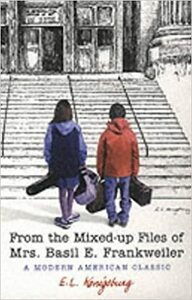You need to sign in or sign up before continuing.
Take a photo of a barcode or cover
Besides the very dated little bit where the kids talk about how Marijuana will turn them into brainless dope fiends, the rest of this was a fun little story that should appeal to anyone's childlike sense of adventure and mystery
adventurous
funny
informative
lighthearted
mysterious
reflective
fast-paced
Plot or Character Driven:
A mix
Strong character development:
Complicated
Loveable characters:
Yes
Diverse cast of characters:
No
Flaws of characters a main focus:
No
It wasn't all that good until the very end. But it was a quick and easy read.
adventurous
medium-paced
adventurous
funny
hopeful
informative
inspiring
lighthearted
fast-paced
Plot or Character Driven:
Character
Strong character development:
Yes
Loveable characters:
Yes
Diverse cast of characters:
Complicated
Flaws of characters a main focus:
Complicated
Highly recommend going back and reading your favorite childhood books as an adult.
Another book my daughter and I read aloud to each other. I found it just as thrilling as I did when I read it as a kid. One thing struck me: How far we've sunk in our knowledge of English grammar. I envy Claudia in her certainty of always knowing the proper way to say something.
adventurous
funny
reflective
slow-paced
Plot or Character Driven:
Character
Strong character development:
Yes
Loveable characters:
Yes
Diverse cast of characters:
No
Flaws of characters a main focus:
Yes
Loved this as a kid! I didn't see all the family's privilege until this reread. However, what a fun adventure and story!
adventurous
funny
relaxing
medium-paced
Plot or Character Driven:
A mix
Strong character development:
Yes
Loveable characters:
Yes
Diverse cast of characters:
No
Flaws of characters a main focus:
No
I loved this book when I was a child. Reading it again after more than 35 years, I am struck by things to which my 10-year old self would not have been sensitive. I grew up in a similar social class to the children in this book, but their staggering level of privilege reads rather awkwardly to me now. The protagonist, sixth-grader Claudia Kincaid, complains of grave injustices, such as having such a small allowance that if she buys herself a sundae once a week, she only has ten cents left over. Childhood me might have raised a fist in solidarity — “Right on!” Twenty-first-century me wonders how children who don’t have an allowance might feel about Claudia’s worldview.
But given the upbringing I had, a comfortable New York childhood that included plenty of visits to the Metropolitan Museum of Art, I am susceptible to the romance that gets Claudia Kincaid and her little brother Jamie running away from home and taking up secret residence in the museum. And I’m sensitive now to the technical construction of a book, and so appreciate all the more the magnificent voice of The Mixed-Up Files. It’s told as a letter from Mrs Frankweiler, a very rich, very eccentric old lady, to her lawyer, explaining the story behind a change she wants made in her will. As such it has a powerful and unusual voice, an omniscient narrator who is distant and wise, yet intimate and empathetic, loaded with snark and good humor. The voice of Mrs Frankweiler, more than anything else, makes the book fun for me to read as an adult.
For while my favorite bits are there in the book right as I remembered them, they nevertheless aren’t as drawn out, don’t loom as large or last as long, as an adult reader might like. So I was once again delighted by the trenchant observation that if you think of something to do in New York, two thousand other people have thought of the exact same thing, and one thousand of them are standing in line waiting to do it (I’ve quoted this line many times in the decades since my last reading); and by Claudia and Jamie’s bath in the museum’s fountain and their giddy discovery of its generous supply of coins; and by the tension of hiding in the bathroom and waiting for the guards to pass. But some of the conflicts felt resolved too quickly, perhaps even to be satisfying to child readers, I don’t know. For instance, the eponymous files are not quite as mixed-up as I remember them, and it takes only a paragraph for Claudia to find the file she’s looking for, the one containing information about the sculpture she’s fallen in love with. I had remembered, too, that the file was under B for “beauty,” rather than for “Bologna,” but Mrs Frankweiler’s filing system, it turns out, is more practical than romantic. Funny that my brain applied such an edit; with respect to Ms Konigsburg, I think my version is better.
At any rate some of the lasting appeal for me is that it’s a kind of kid version of one of my favorite movies, How To Steal a Million, in which the deliciously stylish duo of Peter O’Toole and Audrey Hepburn lurk around a great art museum after closing, determined, just like Claudia and Jamie, to uncover the secrets of a mysterious sculpture. That movie, incidentally, is roughly contemporaneous with The Mixed-Up Files — there must have been something in the zeitgeist, at a time when news stories about recovering and authenticating Nazi caches of stolen art were not uncommon.
But given the upbringing I had, a comfortable New York childhood that included plenty of visits to the Metropolitan Museum of Art, I am susceptible to the romance that gets Claudia Kincaid and her little brother Jamie running away from home and taking up secret residence in the museum. And I’m sensitive now to the technical construction of a book, and so appreciate all the more the magnificent voice of The Mixed-Up Files. It’s told as a letter from Mrs Frankweiler, a very rich, very eccentric old lady, to her lawyer, explaining the story behind a change she wants made in her will. As such it has a powerful and unusual voice, an omniscient narrator who is distant and wise, yet intimate and empathetic, loaded with snark and good humor. The voice of Mrs Frankweiler, more than anything else, makes the book fun for me to read as an adult.
For while my favorite bits are there in the book right as I remembered them, they nevertheless aren’t as drawn out, don’t loom as large or last as long, as an adult reader might like. So I was once again delighted by the trenchant observation that if you think of something to do in New York, two thousand other people have thought of the exact same thing, and one thousand of them are standing in line waiting to do it (I’ve quoted this line many times in the decades since my last reading); and by Claudia and Jamie’s bath in the museum’s fountain and their giddy discovery of its generous supply of coins; and by the tension of hiding in the bathroom and waiting for the guards to pass. But some of the conflicts felt resolved too quickly, perhaps even to be satisfying to child readers, I don’t know. For instance, the eponymous files are not quite as mixed-up as I remember them, and it takes only a paragraph for Claudia to find the file she’s looking for, the one containing information about the sculpture she’s fallen in love with. I had remembered, too, that the file was under B for “beauty,” rather than for “Bologna,” but Mrs Frankweiler’s filing system, it turns out, is more practical than romantic. Funny that my brain applied such an edit; with respect to Ms Konigsburg, I think my version is better.
At any rate some of the lasting appeal for me is that it’s a kind of kid version of one of my favorite movies, How To Steal a Million, in which the deliciously stylish duo of Peter O’Toole and Audrey Hepburn lurk around a great art museum after closing, determined, just like Claudia and Jamie, to uncover the secrets of a mysterious sculpture. That movie, incidentally, is roughly contemporaneous with The Mixed-Up Files — there must have been something in the zeitgeist, at a time when news stories about recovering and authenticating Nazi caches of stolen art were not uncommon.




